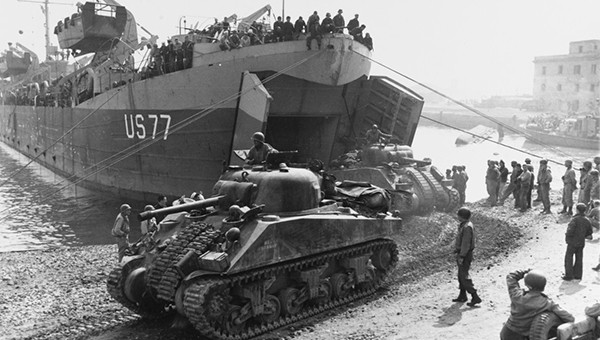
Operation Shingle: USS LST-77 lands Fifth Army M-4 Sherman tanks on the Anzio waterfront. German pressure on the Allied beachhead had eased to some extent by this time. For more information click on this link.
By: Phil Kohn. Dedicated to the memory of his father, GM3 Walter Kohn, U.S. Navy Armed Guard, USNR, and all men and women who have answered the country’s call in time of need. Phil can be contacted at ww2remembered@yahoo.com.
On January 21, the Luftwaffe conducts its largest raid on Great Britain in some time, with 90 planes being spotted over southeast England during what comes to be called “the Little Blitz.” The RAF sends 648 bombers to attack Magdeburg, in east central Germany. In Russia, German forces in the Petergof and Strelna areas around Leningrad are essentially wiped out.
The Allies begin “Operation Shingle,” a second amphibious landing in Italy, on January 22, catching the Germans by surprise. Just after midnight, the U.S. Fifth Army lands two divisions (36,034 American and British soldiers and 3,069 vehicles sent from Naples) under Maj. Gen. John P. Lucas at Anzio, 30 miles south of Rome. The strategy is to outflank German troops on the so-called “Winter Line” (three lines of defense — the Gustav, Bernhardt and Hitler Lines — strung across Italy to the south) in order to move on Rome. In Russia, Field Marshal Georg von Küchler, whose Army Group North’s stranglehold on Leningrad is slipping, is replaced by Col.-Gen. Walter Model, in whom Hitler has more faith.
Allied patrols venturing inland from Anzio on January 23 are halted by increasing German resistance. The German High Command has transferred German reserves from France, northern Italy and the Balkans, as well as the German Fourteenth Army headquarters to organize defenses around Anzio. Within a week a total of eight German divisions are concentrated in the area. Meanwhile, back home in the U.S., life goes on as the Detroit Red Wings register the most lop-sided victory in National Hockey League history by defeating the New York Rangers, 15-0.
In Italy, the U.S. Army’s 36th Infantry Division on January 24 suffers a major setback at the Rapido River, suffering heavy casualties. It finally manages a bridgehead, allowing Allied armored vehicles to cross, but the battle ends in a German defensive victory. At the other end of the Allied line, French colonial troops under Gen. Alphonse Juin continue to gain ground. In the Mediterranean off Anzio, the British hospital ship TSS St. David — well-marked, well-lit, and loaded with wounded soldiers — is sunk by German aircraft. Of the 229 aboard, 93 die.
Forces of the U.S. Fifth Army continue attacks on the German-held Gustav Line in Italy on January 25. French and Algerian troops make some gains on Monte Belvedere and Colle Abate (bypassing Cassino) but are halted by a lack of reserves to preserve their momentum. At Anzio, Allied efforts to expand the beachhead make slow progress.
British and Indian troops launch an attack on the Japanese in Arakan, in western Burma, on January 26. The African nation of Liberia declares war on Germany and Japan. Argentina — under pressure from the United States for months — finally severs diplomatic relations with Germany and Japan when it discovers a vast Axis spy network operating in the country.
By January 27, the combined efforts of four Red Army Fronts (Leningrad, Volkhov and 1st and 2nd Baltic) and aircraft from the Soviet Baltic Fleet have forced German troops away from the southern approaches of Leningrad, breaking the long siege. The Moscow-Leningrad railway is cleared and resumes operations. The 13th heavy air raid against Berlin kills an estimated 6,000 people. In Italy, the U.S. Fifth Army continues attacks on the Gustav Line. The British X Corps attacks German positions at Santa Maria Infante. The U.S. 34th Division (part of II Corps) captures Caira, about 3 miles north of Cassino. Some seven miles farther north, Gen. Juin’s Free French near Colle Abate are pushed back by German counterattacks. The governments of Australia, Great Britain and the U.S. formally protest the Japanese treatment of prisoners of war. The three nations indicate they are determined to investigate and punish those responsible for criminal activities.



